Overcoming the Dark Side of Compact Fluorescents
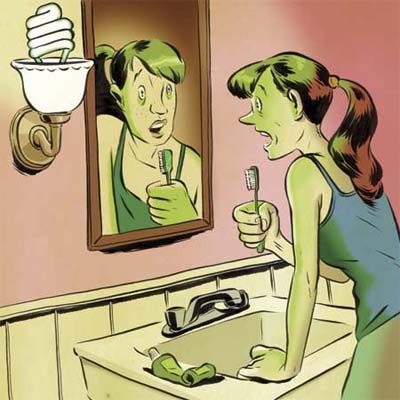
Of all the ways to cut your electric bills, twisting in a CFL might just be the easiest. You don’t have to build a backyard wind farm or set the thermostat so low you’ve got to sleep in down pajamas. Just replace incandescent bulbs with CFLs, which sap 75 percent less energy, and you could slash hundreds off your annual electricity expenses. And over the long haul you’ll save on bulbs, too, because they last up to 10 times longer than incandescents.
It’s that simple. And yet many of you aren’t using CFLs. We know this because you told us so in a recent poll on our messageboards. Among your gripes were slow start-up times, the greenish light CFLs cast, and their mercury content. But they don’t deserve such a bad rap anymore, says sustainable lighting designer Mark Loeffler of New Haven, Connecticut. “The bulbs you buy today are far better than what was on the market just a few years ago,” says Loeffler. No, they’re still not ideal for every light fixture and application, but most of the big problems have been solved. Take, for example, the following concerns from your fellow readers.
Morning Reflection
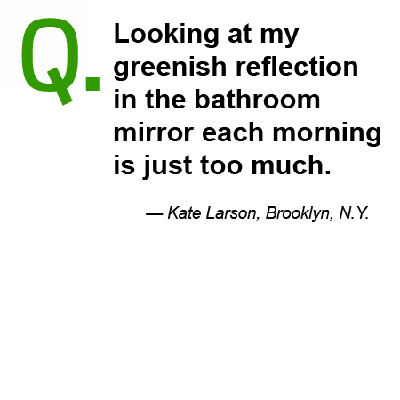
A. Bulbs that burn a filament, such as incandescents, provide the full spectrum of light, approximating sunshine and giving everything a natural glow. A CFL’s spiral tube is filled with gas, which produces ultraviolet light that is, in turn, reflected into a room as white light by a phosphorous coating on the glass. That coating can distort colors and give skin a ghoulish hue. By altering the phosphor manufacturers have recently improved the quality of CFL light, as measured by the color rendering index. This gauges how accurately a bulb renders colors, from 0 to 100, with incandescents scoring a 100. Today’s CFLs are in the 80s, which is good for ambient light. But they’re still not great for task lighting. So keep incandescents in the bath, in the laundry where you need to do spot treating, and where you prep food in the kitchen. Replacing bulbs elsewhere in the house will still save you money.
Seeing the Light
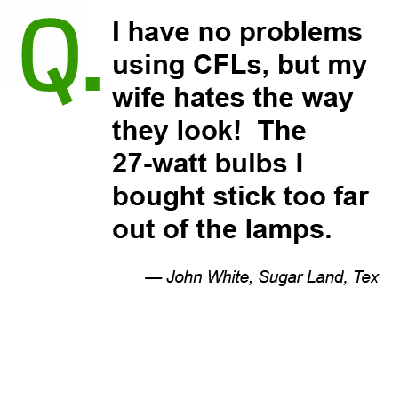
A. All that’s inside an incandescent bulb is a glowing wire filament. The gas-filled tube of a CFL isn’t as easy to squeeze into a petite package. The higher the wattage, the more gas and the bigger the spiral. That 27-watt bulb of yours compares with a 100-watt incandescent. But thanks to new, smaller plastic ballasts, the section above the screw base that houses the bulb’s circuitry, manufacturers are now making CFLs in standard incandescent sizes. Before you shop for a new CFL, measure the length of the bulb you’re replacing, and bring a ruler to the store. Many online sellers also list dimensions on their websites.
How to Light Up a Room
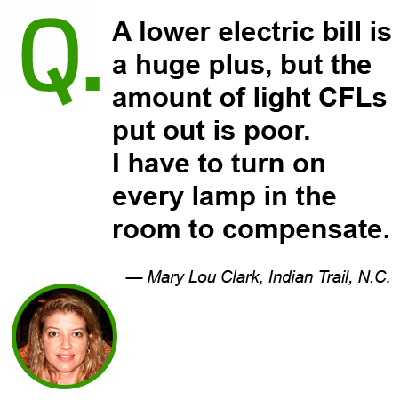
A. The short answer is, you may need to buy a brighter bulb. Here’s why: Those suggested CFL equivalences, which say that a 27-watt CFL equals a 100-watt incandescent, for example, are based on the overall light output of the bulbs. But because CFL light appears more diffuse, the same output isn’t always enough. You may need to up
the ante by replacing a 100-watt incandescent with a 150-watt equivalent CFL, for instance. That brighter light is only 42 watts in incandescent-speak and therefore safe for a fixture with one of those 60watt-maximum warning labels. And it’s still cheaper to use.
Shady Decisions
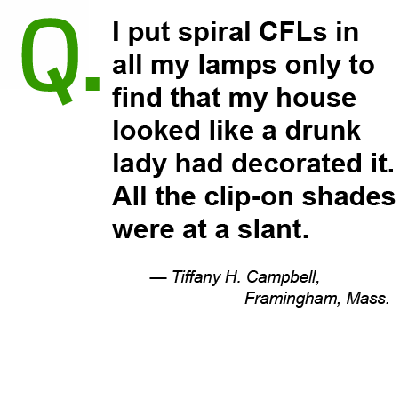
A. A new style of CFL addresses the clip-on shade dilemma, as well as fixtures where the bulb is visible, by putting the spiral inside a round glass globe. Most companies, including Philips, Sylvania, and General Electric, sell these under the names “bulb-shaped,” “covered,” or “capsule.” But the term that matters, and what should be on the packaging, is A19, the shape for standard incandescents. An A21 label signifies the same shape but a slightly larger bulb.
Talking Trash
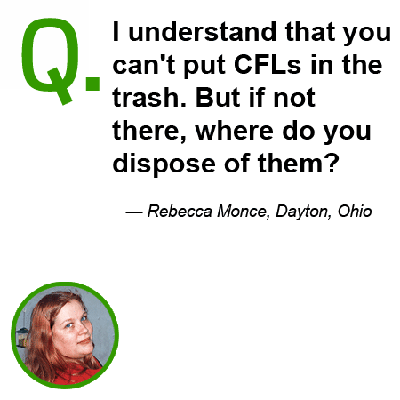
A. Like rechargeable batteries, CFLs contain mercury, which can harm the environment if dumped or incinerated. Some CFLs now come with postage-paid recycling envelopes, and The Home Depot recently announced that it’ll accept any CFL for recycling, no matter where it was purchased. Manufacturers then take those spent bulbs and recapture the mercury inside to make new ones.
Safety First
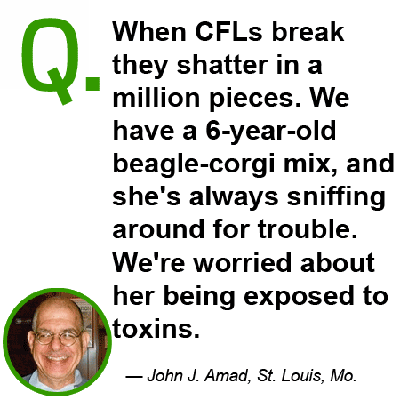
A. CFL bulbs contain about 4 milligrams of mercury, although in some new ones it’s as little as 1.4 milligrams. That compares with 500 milligrams in old-fashioned thermometers. The mercury is harmless if it’s inside the bulb, but it will get released as a gas if the bulb shatters. Should one break on your hard kitchen floor, for instance, you don’t have to call the local hazmat unit. Just open the windows, and leave the area for a minimum of 15 minutes—typically enough time for the mercury vapor to either exit the house or disperse to a harmless level. Then use a piece of cardboard to scoop the debris into a Ziploc bag and bring it to a recycling facility that accepts “universal waste.” Be sure to get every bit of broken glass because it can be coated with trace amounts of mercury. Log onto EPA.gov for more cleanup tips.
Setting the Mood
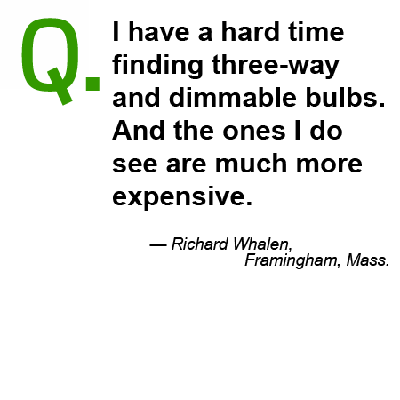
A. Although three-way and dimmable CFLs were fairly exotic just a year ago, they’re now widely available from home centers, megamarts, and online retailers. The problem is their complex internal wiring makes these bulbs pricey at $10 to $15 a pop. And you don’t want a cheap knockoff. It’ll be oversized, offer harsh light, and may not move smoothly between brightness settings. Earthtronics offers good three-way CFLs, as well as dimmables for all types of fixtures.
Not Always the Best Option
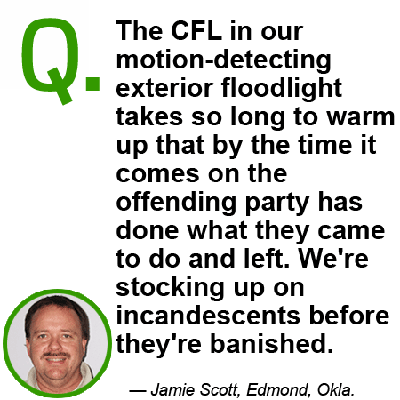
A. An exterior security light is a bad spot for a CFL. Inside the house, the start-up time for today’s CFL is just a fraction of a second. But if the gas inside the bulb is cold, as it can be outdoors or in an unfinished basement or attic, it can take a few minutes for it to warm up and the bulb to brighten. Also, CFLs provide big energy savings only if used in lights that are left on for extended periods. The frequent on-and-off switching of a motion detector shortens the bulb’s life.
And despite some erroneous reports, you’ve got plenty of time to buy incandescents. The 2007 energy bill requires a 30 percent efficiency improvement by 2012. Today’s incandescents can’t do that, but GE says it’s developing ones that will. It’s also possible that something entirely different will become the next standard. One contender is light-emitting diode (LED) bulbs, the technology behind flat-screen TVs. In any case, the efficiency deadline is years away, so there’s no need to go buying up all those old incandescent floods at the home center. Besides, something even better’s bound to come along in the next few years.
